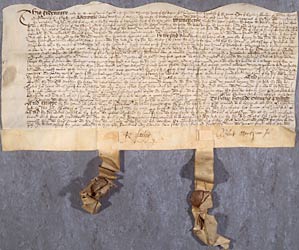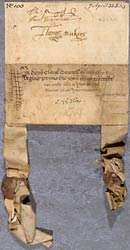Bargain and sale
This form of conveyance had existed since the fifteenth century, but came into its own in 1535 under the Statute of Enrolments, as an alternative to the feoffment.
Bargain and sales of freehold property were supposed to be enrolled (registered) in one of the royal courts at Westminster, or in a county court. A memorandum of enrolment almost always appears on the back of the deed - headed 'Irotulatur' in Latin.
Some deeds from the sixteenth century onwards were hybrid documents combining elements of the feoffment with elements from a deed of bargain and sale. These are described in archival catalogues variously as 'feoffment', 'bargain and sale with feoffment', or 'bargain and sale with livery of seizin'. They use the form of words from a bargain and sale, but lack an enrolment. Instead, they include a memorandum of livery of seizin. An example is given in the section relating to feoffments.
Purpose
Sale of real property (land or buildings) from one party to another, for a monetary consideration.
Features of bargain and sales
-
16th-19th centuries
- medium to large size
- written on parchment
- usually written in English; some written in Latin until 1733
- indenture (wavy top edge)
- seal
- memorandum of enrolment on the back
Important words and phrases
A bargain and sale records in the past tense what has been done to transfer the property. The classic form of words in a bargain and sale is as follows:
[Latin] Concessi vendidi bargendisavi ...
[English] Have granted, bargained and sold ...
There will usually be a financial consideration stated; and the property is conveyed for ever. There will be a memorandum of enrolment on the back. Until 1733 this was in Latin and began 'Irotulatur'...
User beware!
If you find a document which uses the stock phrases of a bargain and sale, but which is made out for a limited term of 6 months or 1 year, with a consideration of 5 shillings, and a rent of one peppercorn per year, then it is probably not a bargain and sale. It is probably the 'lease' part of a lease and release.
Example
Ne D 2281 - Bargain and sale from Robert Markham and his son, Robert to John Holles [later 1st Earl of Clare] of the manor of Maplebeck, Nottinghamshire; 7 Apr. 1591


View this deed: front | reverse
This is a good example of a classic deed of bargain and sale and illustrates the changes that had taken place in deed forms since the medieval period. It is written on a medium sized piece of parchment, 42 cm wide by 21 cm long. It is in English, but the scribe is continuing to use medieval-style abbreviations. The spellings are also slightly different to the present day.
We know it is a bargain and sale because of the following characteristics:
- It is an indenture, that is, the top of the deed is cut in a wavy line. This indicates that the deed was made between two or more parties. Some pairs of indentures were cut from the same sheet of parchment, and could be verified by checking that the top parts of each fitted together correctly
- It begins with the words 'This Indenture...'
- It includes the phrase 'granted bargained and sold'
- The consideration is stated in full
- The land is transferred to John Holles and his heirs and assigns (i.e. in fee simple) for ever
- It has been sealed by the two people selling the land
- On the reverse side, there is a memorandum of enrolment in Chancery
This transcription of the important parts of the bargain and sale has been broken down into the standard sections common to most deeds from the early modern period onwards.
Date
[line 1] This Indenture made the seaventh daie of Aprill in the three and thirtieth year of the Raigne of o[ur] Sou[er]aigne Ladie Elizabeth by the grace of god of England France & Ireland Queen
[line 2] defendour of the faythe &c.
Parties
[line 2] Betweene Robert Markham of Cottham in the countye of Nottingham esquier and Rob[er]t Markham gent[leman] sonne and heire apparant of the said Rob[er]t Markham of
[line 3] the one p[ar]tie, And John Hollis of Haughton in the said countye of Nottingham esquier of the other p[ar]te
Operative Parts or 'Testatum'
[line 3] Witnessethe that the said Robert Markham the father and Robert Markham the sonne aswell
[line 4] for and in Considerac[i]on of the some of two thowsand poundes of Lawfull english monie to the said Robert Markham the father and Robert Markham the sonne before hand paid ....
[line 7] he the said Robert Markham the father hath graunted bargayned and sould and by theis p[rese]nts
[line 8] Dothe fullie freelie and absolutelie graunt bargaine and sell unto him the said John Hollis his heires and assignes for ever
Parcels
[line 8] All that the Mannor of Lordshippe of Malebecke al[ia]s
[line 9] Maplebecke w[i]thin the countie of Nottingham w[i]th all the hereditam[en]ts rights members rents s[er]vic[es] & other thapp[ur]ten[a]nc[es] to the same Mannor of Malebecke belongeinge...
[line 10] ... And all edific[es] buylding[es], barnes stables
[line 11] orchard[es] doffehowses and all other howses of office ... And all that that the p[ar]ke
[line 12] or ympaled ground replenished w[i]th deere in Malebecke aforesaid; Together w[i]th all glasse waynscott portalls and other fixed ymplem[en]ts of household and husbandrye, And all Pales Railes
[line 13] stoopes and game of deere ...
[line 14] ... And all and singuler other Landes tenem[en]t[es] messuag[es] Cotag[es] Tofts croft[es] barnes stables doffehouses mylnes orchard[es] gardens meadowes demeynes pastures feeding[es] woodd[es]
[line 15] und[er]wooddes wast[es] com[m]ons rent[es] reu[er]c[i]ons s[er]vic[es] Court leet court Barrons w[i]th the p[er]quisit[es] & p[ro]fitt[es] thereof waifes straies and fellons goodes happeninge w[i]thin the said Manor & all
[line 16] waters and water courses pond[es] fishing[es] fowleing[es] hawking[es] hunting[es] franchesies liberties R[o]yalties p[ro]fitt[es] Comodities & hereditam[en]t[es] ...
[line 17] ...as p[ar]t or p[ar]cell of the said Manor of Malebecke...
[line 21] ... Together also w[i]th all deed[es] Ch[arte]res Evidenc[es] Wryting[es] receipt[es] scrowles
[line 22] mynim[en]t[es] Rentalls and Court Roules ...
'Habendum'
[line 22] To have houlde occupie possesse
[line 23] and enioye the said Mann[or] ...
[line 24] unto the said John Hollis his heires and assignes for ev[er] To the onelie p[ro]p[er] benefitt use and behoofe of him the said John Hollis his heires & assignes for ev[er]
Covenants, Conditions and Provisos
[line 25] And the said Robert Markham the father and Robert Markham the sonne for them and their heires the forerecyted Mannor or Lordshippe ...
[line 27] shall warrant and defend for ever ...
Witnesses
[line 28] In witnes whereof the p[ar]ties abouesaid to theis p[rese]nte Indentures int[er]changeablie haue sette their hand[es] and seales the daie and yeare first aboue wrytten
[Signatures of Ro. Markham and Robert Markham ju[nior]]
Endorsements
[Signatures of four witnesses]
[Memorandum of enrolment, in Latin:]
[line 1] I[rotulatur] in dors Claus Cancellar[ius] infrascr[ipte] d[omi]ne
[line 2] Regine primo die Maii Anno infrascr[ipto]
[line 3] Per Wil[e]lm[um] Herd et Joh[an]em Baylye
[line 4] Deputat[is] Cl[er]icis Irrotulamento[rum]
[Translation:]
[line 1] Enrolled on the dorse of the Rolls of the Chancery of the within-written Lady
[line 2] Queen on the first day of May in the within-written year,
[line 3] by William Herd and John Baylye,
[line 4] Deputy Clerks of Enrolment
Next page: Lease and release